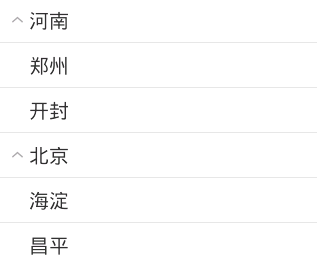Android数据适配-ExpandableListView
Android中ListView的用法基本上学的时候都会使用,其中可以使用ArrayAdapter,SimpleAdapter,BaseAdapter去实现,这次主要使用的ExpandableListView展示一种两层的效果,ExpandableListView是android中可以实现下拉list的一个控件类似于QQ那种我好友之后就是一排自己的好友,就是两层效果,实现的话使用SimpleExpandableListAdapter即可。
布局文件
先看下效果:

main中xml代码:
<Button
android:onClick="test"
android:layout_width="fill_parent"
android:layout_height="wrap_content"
android:text="FlyElephant" /> <ExpandableListView
android:id="@id/android:list"
android:layout_width="fill_parent"
android:layout_height="fill_parent"
android:drawSelectorOnTop="false" />
定义一个省份的province.xml:
<?xml version="1.0" encoding="utf-8"?>
<LinearLayout xmlns:android="http://schemas.android.com/apk/res/android"
android:layout_width="match_parent"
android:layout_height="match_parent"
android:orientation="vertical" > <TextView
android:id="@+id/list_provinceText"
android:layout_width="fill_parent"
android:layout_height="fill_parent"
android:paddingBottom="8px"
android:paddingLeft="30px"
android:paddingRight="5px"
android:paddingTop="8px"
android:textSize="20sp" /> </LinearLayout>
定义了一个地区的child.xml:
<?xml version="1.0" encoding="utf-8"?>
<LinearLayout xmlns:android="http://schemas.android.com/apk/res/android"
android:layout_width="match_parent"
android:layout_height="match_parent"
android:orientation="vertical" > <TextView
android:id="@+id/child_text"
android:layout_width="fill_parent"
android:layout_height="fill_parent"
android:paddingBottom="8px"
android:paddingLeft="30px"
android:paddingRight="5px"
android:paddingTop="8px"
android:textSize="20sp" /> </LinearLayout>
Demo实现
主要实现代码,代码中都已经注释,其中最主要的SimpleExpandableListAdapter中的参数,这个参数太多,很容易弄错,可以看下注释或者API文档:
// 创建一级条目
List<Map<String, String>> provinces = new ArrayList<Map<String, String>>();
//创建两个省份一级条目
Map<String, String> firstProvince= new HashMap<String, String>();
firstProvince.put("province", "河南");
Map<String, String> secondProvince= new HashMap<String, String>();
secondProvince.put("province", "北京");
provinces.add(firstProvince);
provinces.add(secondProvince);
// 创建一级条目下的的二级地区条目
List<Map<String, String>> childList1= new ArrayList<Map<String, String>>();
//同样是在一级条目目录下创建两个对应的二级条目目录
Map<String, String> child1= new HashMap<String, String>();
child1.put("child", "郑州");
Map<String, String> child2 = new HashMap<String, String>();
child2.put("child", "开封");
childList1.add(child1);
childList1.add(child2);
//同上
List<Map<String, String>> childList2 = new ArrayList<Map<String, String>>();
Map<String, String> child3 = new HashMap<String, String>();
child3.put("child", "海淀");
Map<String, String> child4 = new HashMap<String, String>();
child4.put("child", "昌平");
childList2.add(child3);
childList2.add(child4);
// 将二级条目放在一个集合里,供显示时使用
List<List<Map<String, String>>> childs = new ArrayList<List<Map<String, String>>>();
childs.add(childList1);
childs.add(childList2);
/**
* 使用SimpleExpandableListAdapter显示ExpandableListView
* 参数1.上下文对象Context
* 参数2.一级条目目录集合
* 参数3.一级条目对应的布局文件
* 参数4.fromto,就是map中的key,指定要显示的对象
* 参数5.与参数4对应,指定要显示在groups中的id
* 参数6.二级条目目录集合
* 参数7.二级条目对应的布局文件
* 参数8.fromto,就是map中的key,指定要显示的对象
* 参数9.与参数8对应,指定要显示在childs中的id
*/
SimpleExpandableListAdapter adapter = new SimpleExpandableListAdapter(
this, provinces, R.layout.list_group, new String[] { "province" },
new int[] { R.id.list_groupText }, childs, R.layout.child,
new String[] { "child" }, new int[] { R.id.child_text });
setListAdapter(adapter);
这个mainActivity需要继承ExpandableListActivity,当然你可以设置其中的点击事件,只要重写一下方法即可:
/**
* 设置哪个二级目录被默认选中
*/
@Override
public boolean setSelectedChild(int groupPosition, int childPosition,
boolean shouldExpandGroup) {
//do something
return super.setSelectedChild(groupPosition, childPosition,
shouldExpandGroup);
}
/**
* 设置哪个一级目录被默认选中
*/
@Override
public void setSelectedGroup(int groupPosition) {
//do something
super.setSelectedGroup(groupPosition);
}
/**
* 当二级条目被点击时响应
*/
@Override
public boolean onChildClick(ExpandableListView parent, View v,
int groupPosition, int childPosition, long id) {
//do something
return super.onChildClick(parent, v, groupPosition, childPosition, id);
}
效果如下:

上面这个例子写的有点单调,其实第二个你子的布局直接是空的也行,例如定义一个images.xml
<?xml version="1.0" encoding="utf-8"?>
<LinearLayout xmlns:android="http://schemas.android.com/apk/res/android"
android:layout_width="wrap_content"
android:layout_height="wrap_content"
android:orientation="horizontal" > <ImageView
android:src="@drawable/open"
android:layout_width="20dp"
android:layout_height="20dp" /> <TextView
android:id="@+id/txtName"
android:paddingLeft="10dp"
android:layout_width="wrap_content"
android:layout_height="wrap_content" /> </LinearLayout>
然后定义一个items.xml
<?xml version="1.0" encoding="utf-8"?>
<TextView xmlns:android="http://schemas.android.com/apk/res/android"
android:id="@+id/items"
android:layout_width="wrap_content"
android:layout_height="wrap_content" > </TextView>
代码调用:
public class MyExpandleActivity extends Activity {
/**
* 实现可扩展展开列ExpandableListView的三种方式
* 一是使用SimpleExpandableListAdpater将两个List集合包装成ExpandableListView 二是
* 扩展BaseExpandableListAdpter
* 三是使用simpleCursorTreeAdapter将Cursor中的数据包装成SimpleCuroTreeAdapter
*/
private String[] names = { "腾讯", "百度", "阿里巴巴" };
private String[][] childnames = { { "马化腾", "张小龙","社交"},
{ "李彦宏", "马东敏","搜索" }, { "马云", "陆兆禧","电商" } };
private ExpandableListView ep;
@Override
protected void onCreate(Bundle savedInstanceState) {
super.onCreate(savedInstanceState);
setContentView(R.layout.activity_my_expandle);
// 定义父列表项List数据集合
List<Map<String, String>> group = new ArrayList<Map<String, String>>();
// 定义子列表项List数据集合
List<List<Map<String, String>>> ss = new ArrayList<List<Map<String, String>>>();
for (int i = 0; i < names.length; i++) {
// 提供父列表的数据
Map<String, String> maps = new HashMap<String, String>();
maps.put("names", names[i]);
group.add(maps);
// 提供当前父列的子列数据
List<Map<String, String>> child = new ArrayList<Map<String, String>>();
for (int j = 0; j < names.length; j++) {
Map<String, String> mapsj = new HashMap<String, String>();
mapsj.put("map", childnames[i][j]);
child.add(mapsj);
}
ss.add(child);
}
/**
* 第一个参数 应用程序接口 this 第二个父列List<?extends Map<String,Object>>集合 为父列提供数据
* 第三个参数 父列显示的组件资源文件 第四个参数 键值列表 父列Map字典的key 第五个要显示的父列组件id 第六个 子列的显示资源文件
* 第七个参数 键值列表的子列Map字典的key 第八个要显示子列的组件id
*/
SimpleExpandableListAdapter expand = new SimpleExpandableListAdapter(
this, group, R.layout.images, new String[] { "names" },
new int[] { R.id.txtName }, ss, R.layout.items,
new String[] { "map" }, new int[] { R.id.items });
ep = (ExpandableListView) findViewById(R.id.expanable_mylist);
ep.setAdapter(expand);
}
}
效果跟上面相同:

Android数据适配-ExpandableListView的更多相关文章
- Android中使用ExpandableListView实现微信通讯录界面(完善仿微信APP)
之前的博文<Android中使用ExpandableListView实现好友分组>我简单介绍了使用ExpandableListView实现简单的好友分组功能,今天我们针对之前的所做的仿微信 ...
- Android中使用ExpandableListView实现好友分组
一个视图显示垂直滚动两级列表中的条目.这不同于列表视图,允许两个层次,类似于QQ的好友分组.要实现这个效果的整体思路为: 1.要给ExpandableListView 设置适配器,那么必须先设置数据源 ...
- 【收藏】Android屏幕适配全攻略(最权威的Google官方适配指导)
来源:http://blog.csdn.net/zhaokaiqiang1992 更多:Android AutoLayout全新的适配方式, 堪称适配终结者 Android的屏幕适配一直以来都在折磨着 ...
- Android屏幕适配全攻略(最权威的官方适配指导)(转),共大家分享。
Android的屏幕适配一直以来都在折磨着我们这些开发者,本篇文章以Google的官方文档为基础,全面而深入的讲解了Android屏幕适配的原因.重要概念.解决方案及最佳实践,我相信如果你能认真的学习 ...
- Android屏幕适配dp、px两套解决办法
"又是屏幕适配,这类文章网上不是很多了吗?" 我也很遗憾,确实又是老问题.但本文重点对网上的各种方案做一个简短的总结,和具体使用方法. 若想了解具体Android设备适配的前世因果 ...
- Android屏幕适配全攻略(最权威的官方适配指导) (转)
招聘信息: Cocos2d-X 前端主程 [新浪微博]手机客户端iOS研发工程师 20k-40k iOS 开发工程师 iOS高级开发工程师(中国排名第一的企业级移动互联网云计算公司 和创科技 红圈营销 ...
- Android多分辨率适配
前一阶段开发android项目,由于客户要求进行多分辨率适配,能够支持国内主流的分辨率手机.因此经过了几次开发走了很多弯路,目前刚刚领略了android多分辨率适配的一些方法. 先介绍一下所走的弯路, ...
- 【转】Android屏幕适配全攻略(最权威的官方适配指导)
原文网址:http://blog.csdn.net/jdsjlzx/article/details/45891551 Android的屏幕适配一直以来都在折磨着我们这些开发者,本篇文章以Google的 ...
- android开发之ExpandableListView的使用,实现类似QQ好友列表
由于工作需要,今天简单研究了一下ExpandableListView,做了一个类似QQ列表的Demo,和大家分享一下. 效果图如下: 先来看看主布局文件: <RelativeLayout xml ...
随机推荐
- 论 异常处理机制中的return关键字
Java中,执行try-catch-finally语句需要注意: 第一:return语句并不是函数的最终出口,如果有finally语句,这在return之后还会执行finally(return的值会暂 ...
- 使开发更便捷——Visual Studio 使用技巧——快捷键
下面是.Net开发中常用的快捷键,熟练使用可以提高开发效率: Ctrl + K + C //注释代码 Ctrl + K + U //取消代码注释 Ctrl + k + d //快速格式化代码 Shif ...
- 使用Python发送HTML格式的邮件(收到的邮件有发送方才是正解)
发送html格式的和普通文本格式差不多,只是MIMEText(content,"html","utf-8"))与MIMEText(content,"p ...
- 高并发编程之synchronized
一.什么是线程? 线程,有时被称为轻量级进程(Lightweight Process,LWP),是程序执行流的最小单元.一个标准的线程由线程ID,当前指令指针(PC),寄存器集合和堆栈组成.另外,线程 ...
- Javascript:window.close()不起作用?
一般的窗口关闭的JS如下写法: window.close() 但是呢,chrome,firefox等中有时候会不起作用. 改为下面的写法: window.open("about:blank& ...
- CodeForces600E Lomsat gelral 线段树合并
从树上启发式合并搜出来的题 然而看着好像线段树合并就能解决??? 那么就用线段树合并解决吧 维护\(max, sum\)表示值域区间中的一个数出现次数的最大值以及所有众数的和即可 复杂度\(O(n \ ...
- [BZOJ 4591] 超能粒子炮-改
Link: 传送门 Solution: 记录一下推$\sum_{i=0}^k C_n^i$的过程: 其实就是将相同的$i/p$合起来算,这样每个里面都是一个可以预处理的子问题 接下来递归下去算即可 T ...
- WEB架构师成长之路 三
Web架构师究竟都要学些什么?具备哪些能力呢?先网上查查架构师的大概的定义,参见架构师修炼之道这篇文章,写的还不错,再查查公司招聘Web架构师的要求. 总结起来大概有下面几点技能要求: 一. 架构师有 ...
- Android 打包出现jdk版本错误的问题
Android 打包出现 jdk 版本错误的问题,本质上是 SDK 的问题,与 JDK 无关.如果 SDK 的 API 是24或者更高,就要求 jdk 1.8,我这里指定的 API 是22,所以去勾选 ...
- Codeforces Round #256 (Div. 2) C. Painting Fence
C. Painting Fence Bizon the Champion isn't just attentive, he also is very hardworking. Bizon the Ch ...
